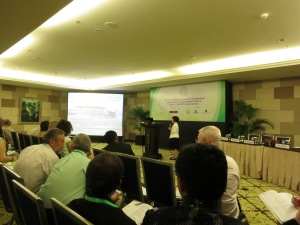With rested brains, it is once more time to stock up on more seaweed, both mentally and physically.
After an opening plenary lecture by Iain Neish about the importance of having a vision and being stubborn if we are to succeed with aquaculture, it was time for a cup of coffee, a slice of fruit cake and the day’s first mini-symposium.
Mini Symposium: Cultivation of tropical red seaweeds
The most common species of red seaweed that are farmed are Eucheuma spp., Kappaphycus spp., Porphyra spp. and Gracillaria spp.
In Chile and Peru, it is primarily Gracillaria spp. that is farmed. In Chile, they seek to develop new methods to cultivate seaweed in the lab, instead of taking material from wild populations as many do today. They have also investigated whether it is possible to grow other commercial species.
In Malaysia, the Philippines and Indonesia, most seaweed is farmed using the fixed off-bottom technique in shallow waters. The trick is to place them deep enough so that the algae are not harmed by the intense sun during low tide.
In deeper water, they use the free-swing method, where only one end is fixed at the bottom. The downside is that it takes up quite a lot of space, and then they must be set at such a distance that they do not become entangled in each other.
Other methods for deeper water is something called single longline rafts, spider web rafts or floating triangle, depending on how you have designed the ropes. But these rafts are secured at all four corners and thus are more stationary. It also means that you can place them closer together, without risking entanglement.
Some growers use hanging baskets that the seaweed is floating freely in, which does not seem like a good idea to me. But this is still at the development stage. They use high pressure water hoses to remove unwanted growth of other seaweed (epiphytes).
Dr. Flower Msuya from Tanzania showed a summary of how seaweed cultivation has started and continued for the East African coast, with examples from Mauritius, Madagascar, Tanzania and Zanzibar course. The main problem to cope with is that they are now beginning to get problems with various diseases. There is much further research to do and a lot of mistakes to learn from. At the same time, a mini-symposium was held in the hall next to this, with the topic being diseases and parasites on seaweed. It’s a hot topic for the seaweed industry.
Presentations: Integrated aquaculture and introductions
In Australia, much yellowtail kingfish and tuna are farmed. At present, there is no cultured seaweed in Australia, so the researchers are now trying to find species suitable for cultivation along with fish farms in order to reduce emissions (IMTA, see previous posts). The species they are looking for are those that are good at taking up nitrogen from fish farms, but there should also be a market for the seaweed.
Kathryn Wiltshire from the University of Adelaide tested several species of red and brown seaweed to see which was best at taking up nitrogen and which grew fastest, in order to select species suitable for further experiments with the conditions that give the best performance.
Tom Schils from the University of Guam (you get extra points if you know where it is without looking it up) told us that coral reefs in Micronesia and the Pacific have very distinct algal communities, which are now threatened by introducing new varieties of these species bred for cultivation. A well-known example is the red alga Acanthophra spicifera that has taken over shallow waters on coral reefs around Hawaii.
Micronesia has a Biosecurity Plan, which seeks to identify and prevent threats to the marine environment, such as how to manage ballast water which is a great disseminator of species from one place to another.
Dr. Yang from China showed how the farming of the red alga Gracillaria spp. is along China’s 18,000-kilometer coastline and how China is now working to develop the use of integrated aquaculture. Between 1967-1980, 50-60% of China’s aquaculture consisted of cultured seaweed, mainly brown alga Saccharina japonica. Since then, the proportion of farmed fish, shrimp, crabs and clams increased. It leads to increased nitrogen load, and you need to cultivate more seaweed to not have problems with eutrophication.
The production of Gracillaria spp. is rising steadily, from 0.13 hectares in 2000 to 1,067 hectares in 2007. In 2011, the total cultivation area of Gracillaria was an astonishing 1,500 hectares!



















